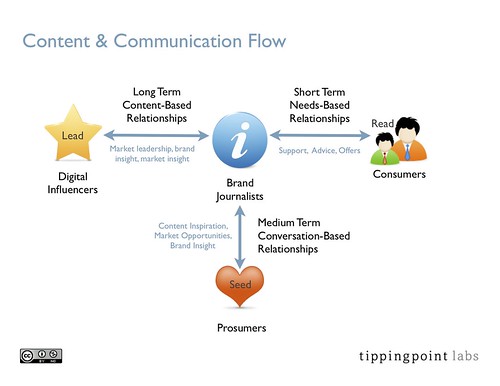“The Influence Pyramid” is designed to show how any brand should start dissecting and defining their online universe. Last night, I had a wonderful conversation with Dan Blank about the Influence Pyramid. Dan, and others, have pointed out that the pyramid doesn’t account for the two-way nature of today’s online universe and they are absolutely right. The Influence Pyramid is merely a way to define the size of your audiences in different strata and showcase the flow of content from a brand’s perspective. In an effort to address Dan’s point, I’ve created a content and communication flow diagram to help illustrate the types of content shared and generated for each audience.
Content and communication flow
Today’s online universe demands two-way brand communication. At the center of the brand’s online universe are Brand Journalists. Brand Journalists must be positioned as objective content creators who live and breathe in the marketplace. There is no one better positioned to provide market insight and information than your brand. Marketing executives must begin to leverage their opportunity to become a media powerhouse in any market they serve.
Digital Influencers need Insight
Today’s digital influencers need a constant flow of market insight and information to ensure their own position in the marketplace. Your brand and your brand journalists can deliver research and information to these influencers that no one (except your competitors) can offer. Build a relationship with these influencers, first, through the generation of valuable content. Prove your chops in the space with high-quality, relevant content that helps elevate the Digital Influencers in the market.
Start a conversation through content. Interact with these influencers online. Read their content. Respond to their comments. Follow them on Twitter. Focus on the value they bring to the marketplace and treat them with the utmost respect.
Channel-specific prosumers and category-specific prosumers
When it comes to Prosumers we know this is a fairly transient community (in general.) We break Prosumers into two separate categories. There are Prosumers who are loyal to a channel and those that are loyal to a category. For example, a Channel Prosumer might purchase product from Amazon.com and always takes the time to write (or create) a high-quality review of every product they purchase online at Amazon. So, if they just bought a camera from Amazon, they’ll review the camera and move on. These are very powerful channel-specific players.
However, a category-specific Prosumer is dedicated to participating in any channel or platform related to their category. For example, if a consumer is really into photography they may participate in a series of deep photo-specific communities and they’ll participate long term.
Both of these types of prosumers are extremely valuable and (of course) also demand respect in the marketplace.
Prosumers generate (or seed) a whole host of content opportunities. Both types of consumers desire interaction at a brand journalist level. They ask intelligent questions, bring up valuable product insight, and, at the end of the day, can help inspire the generation of valuable content.
Consumers desire solutions
At the bottom of the pyramid lies the Consumer. Most social media and major brand marketing is targeted at the vast available audience found at this level.
However, the consumer, is extremely transient. They roll in and out of interactions with your brand based on their specific needs. For example, a consumer looking to purchase your product or service is looking for information and insight into your product until they’ve made a purchase decision. When they’re ready to purchase they need coupon codes, discounts, special offers, bundles, anything that helps them reduce the costs or increase their buying power. After purchase, they are looking for product support, tutorials, or even answers to questions they have as soon as the product arrives.
There are very few (if any) consumers that desire a long term, daily interaction with your brand and the content it creates. That’s not to say they won’t interact with you. It just means you can’t expect them to interact everyday and add value to your brand. You might entice them to enter a contest or even buy another product based on a campaign you’re running in a conversational channel, but it’s unlikely their relationship will last that long.
Content-based approach to each audience
At the end of the day, each of these audiences provide you and your brand with tremendous opportunities to generate valuable content. Prosumers will inspire you to interact and create content. Consumers will gobble up content you create that’s designed to make their purchase and support processes more efficient and digital influencers will engage in long-term content relationships that drive revenue and shift market opinions. Each audience demands two-way communication and requires a channel and platform strategy that delivers on your brand’s promise to interact in the marketplace.

